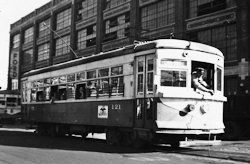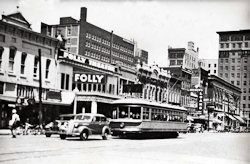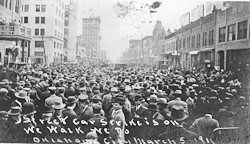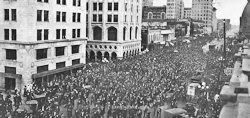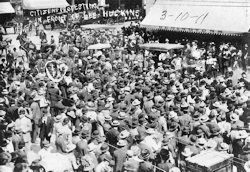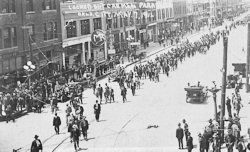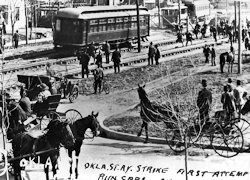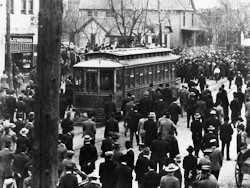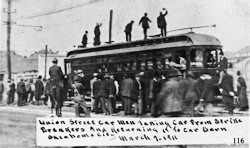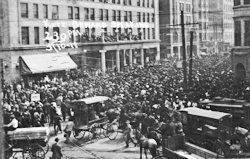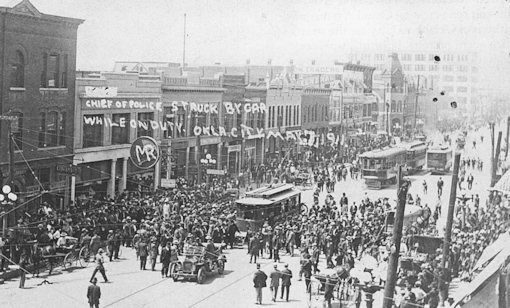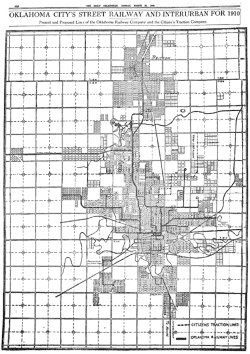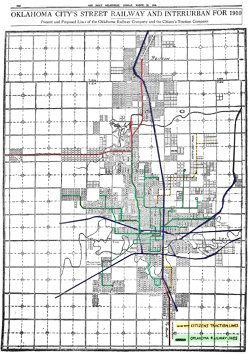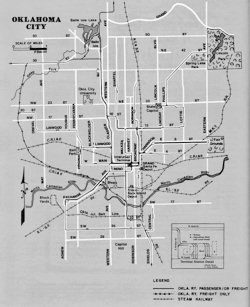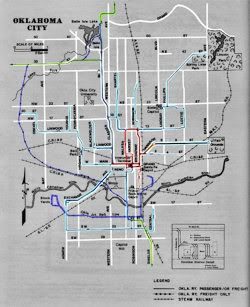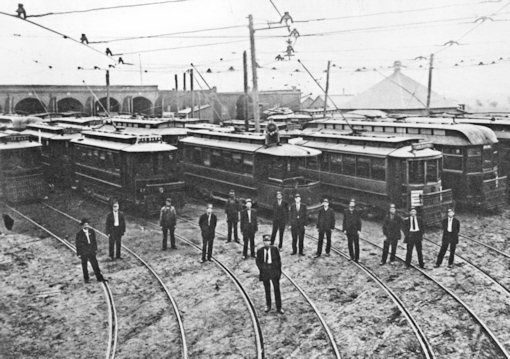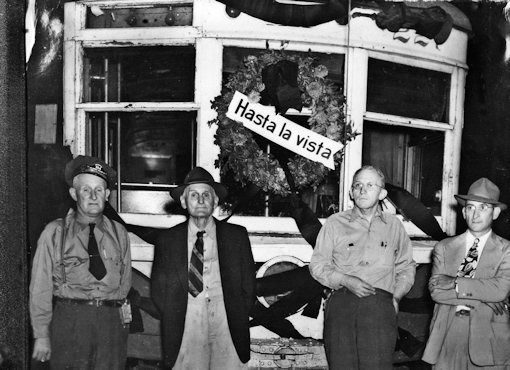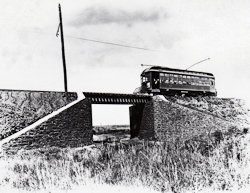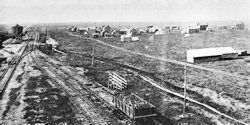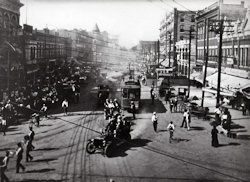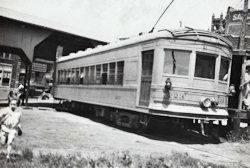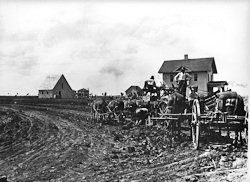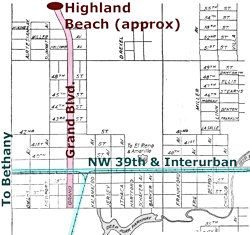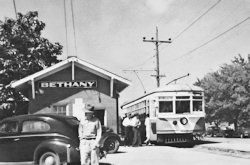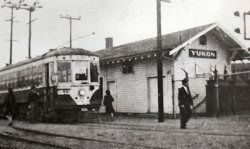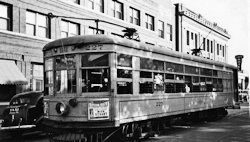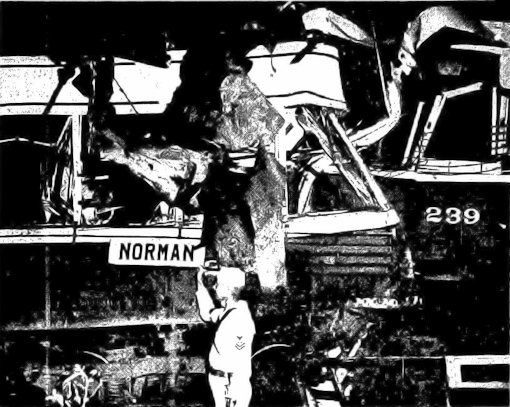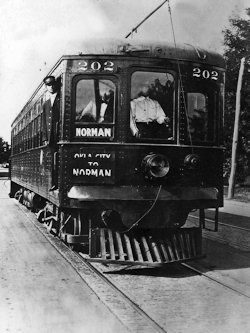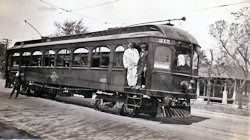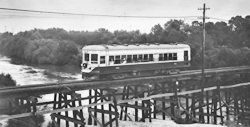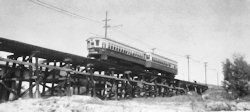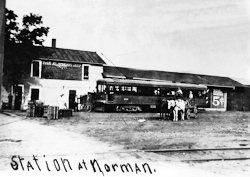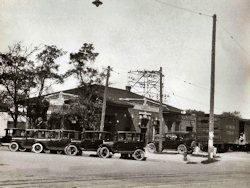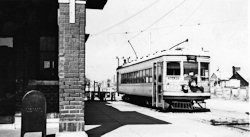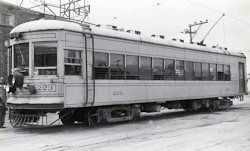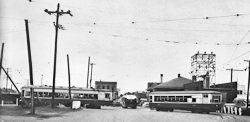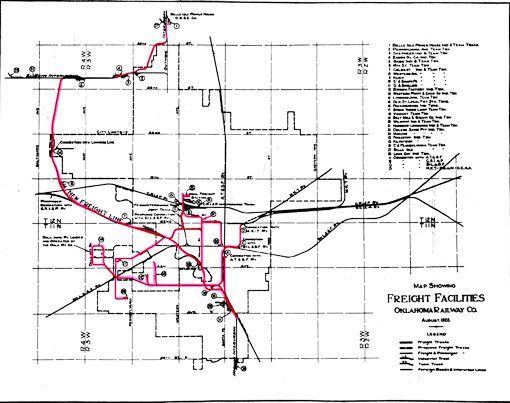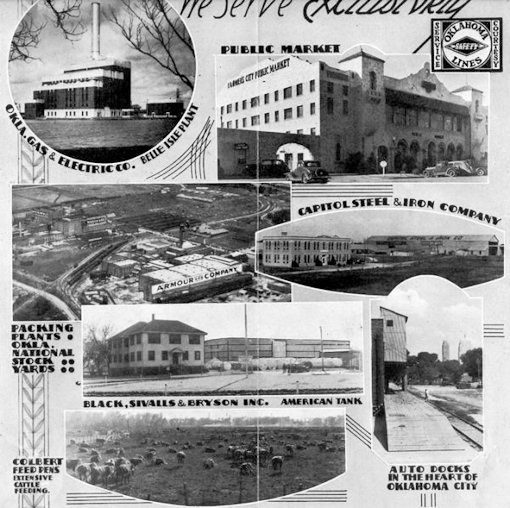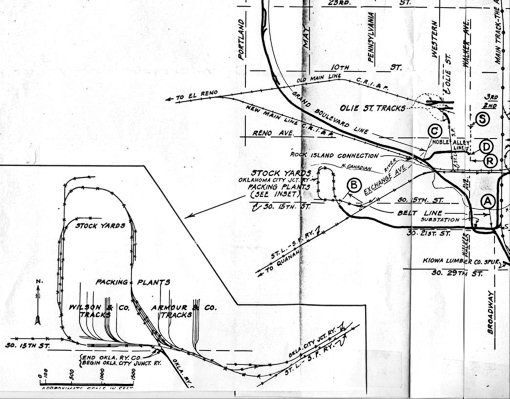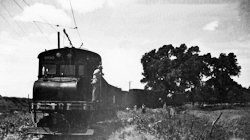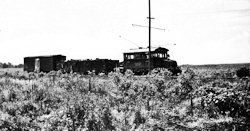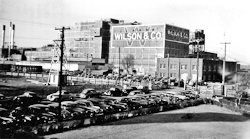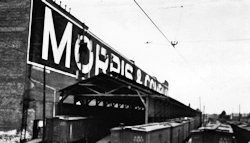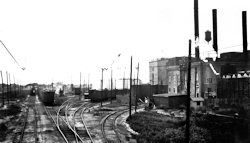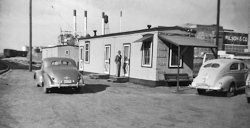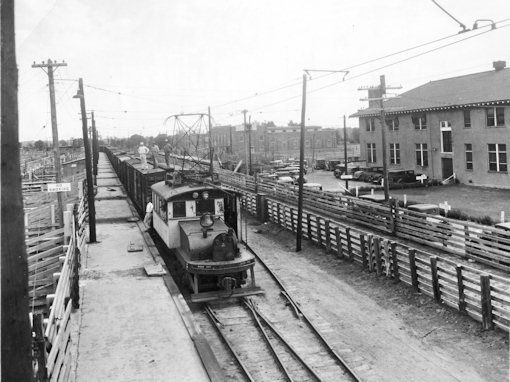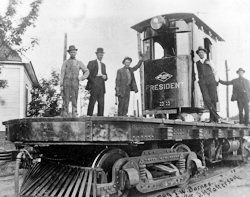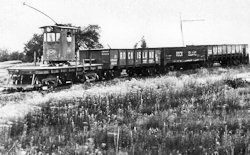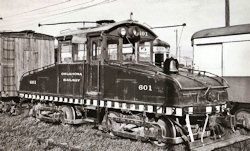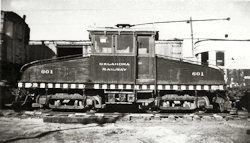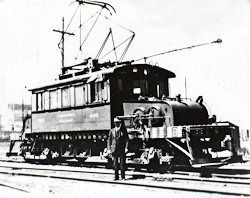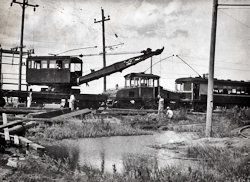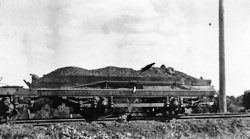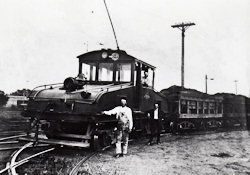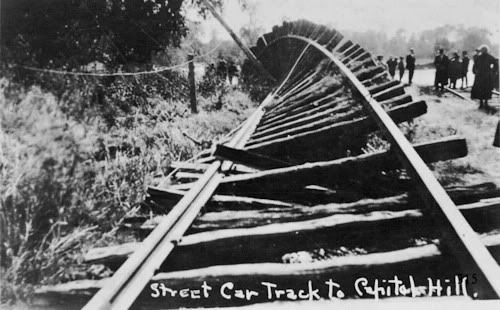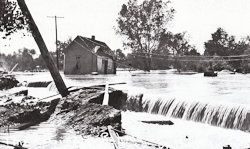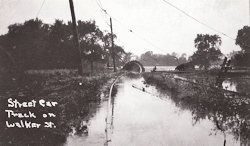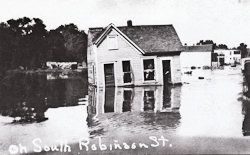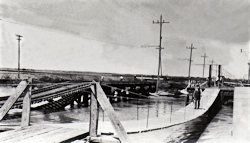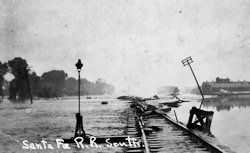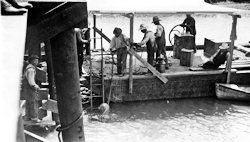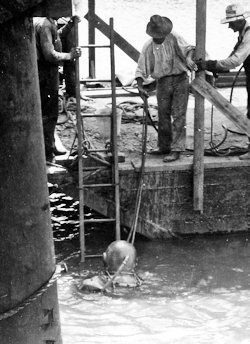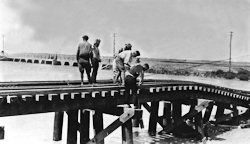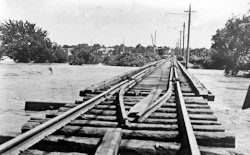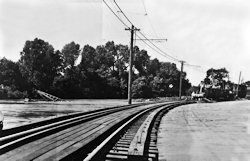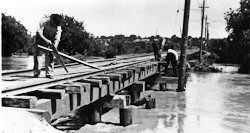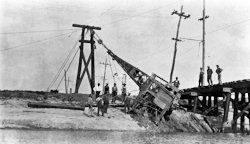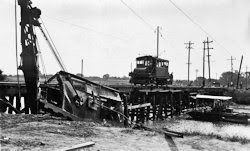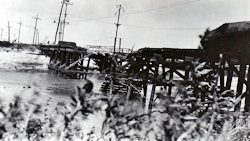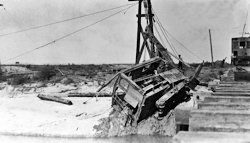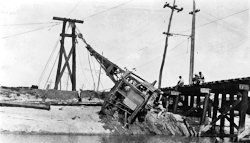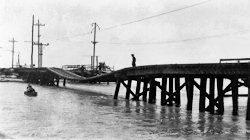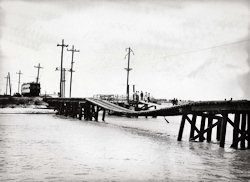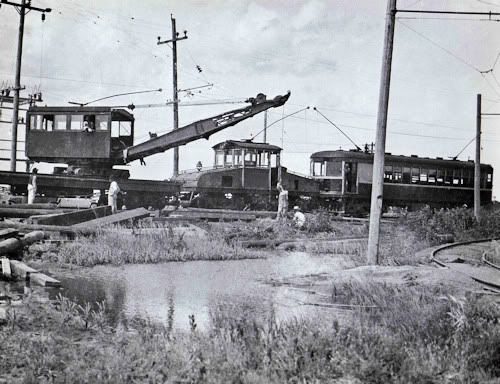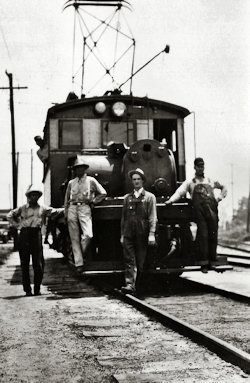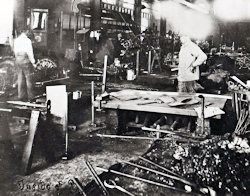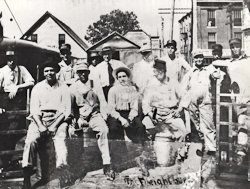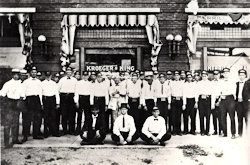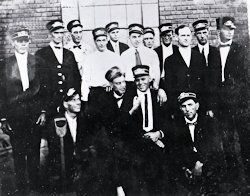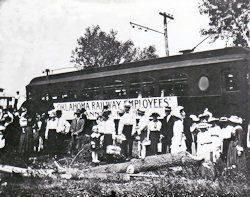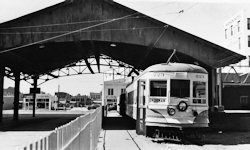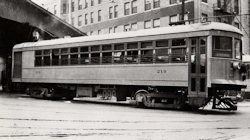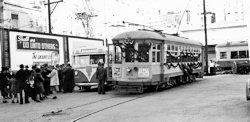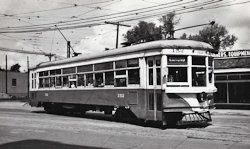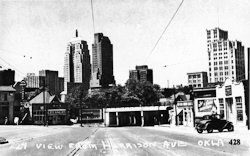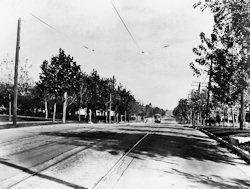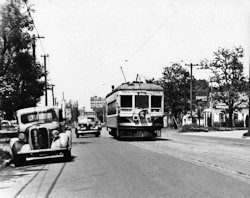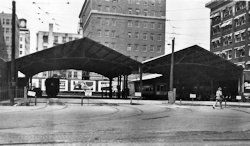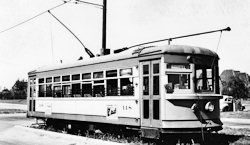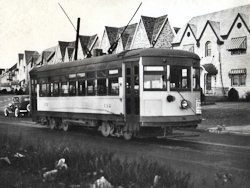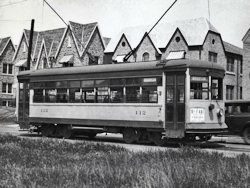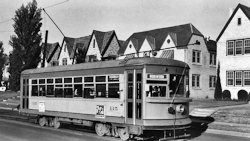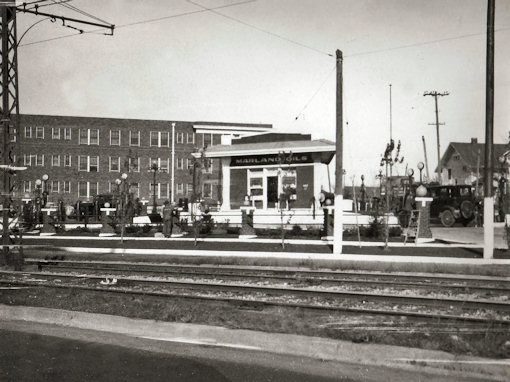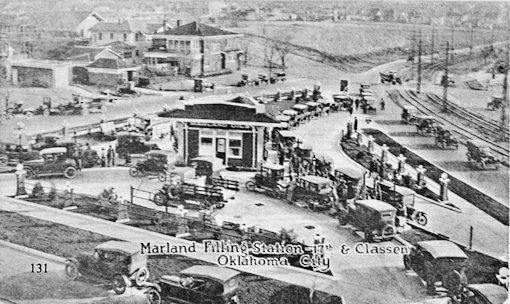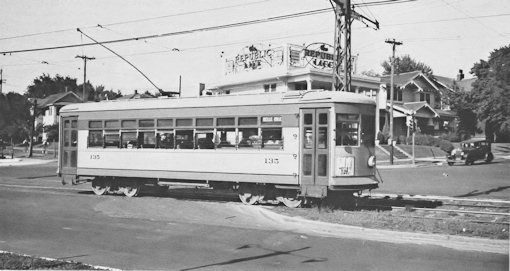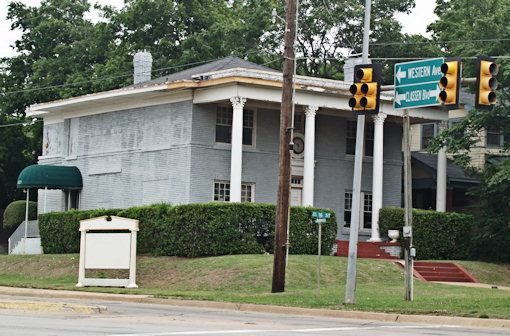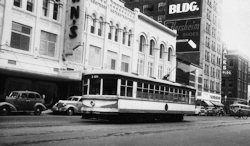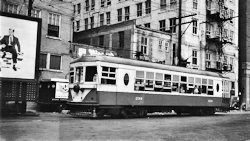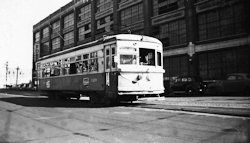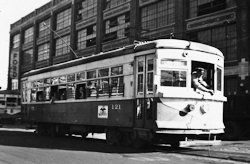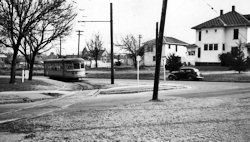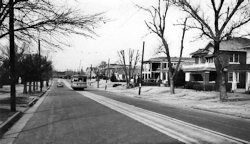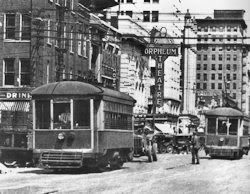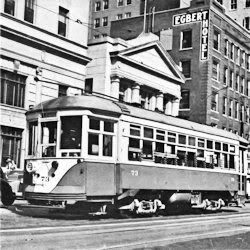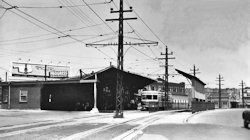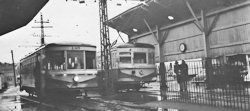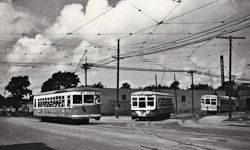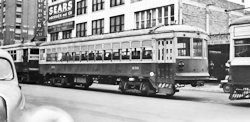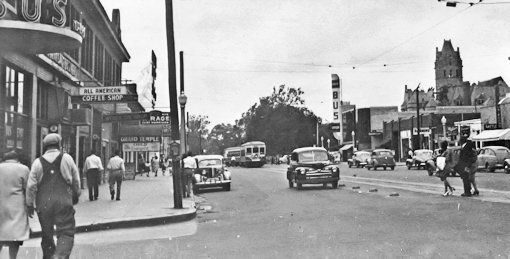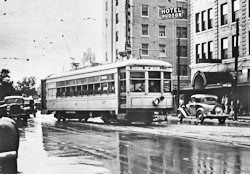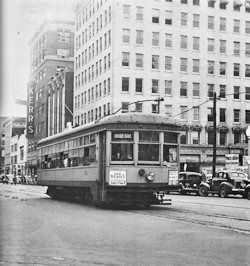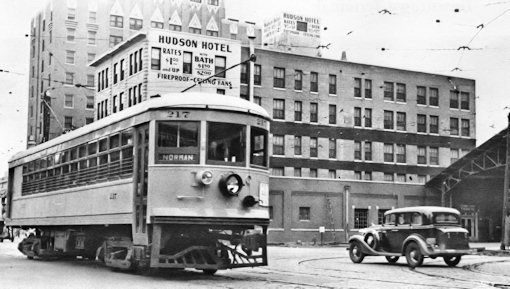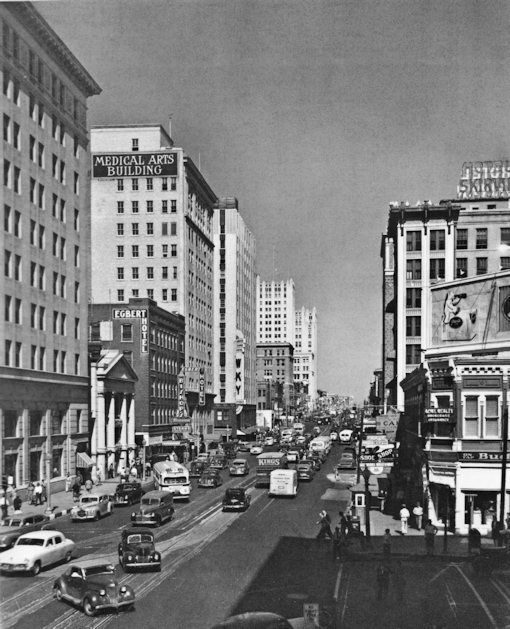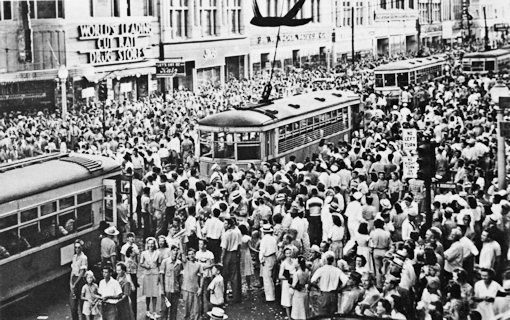Original incomplete post on May 31; updated though June 10, 2010
| Credit VRP
On Main By the Ford Plant |
Credit VRP
On Grand (Sheridan) by Folly Theater |
Now that Oklahoma City is on the verge of have trolleys once again via MAPS 3 (see my Let’s Talk Transit series, at least a starter system downtown), it is apropos that finally I return to trolleys in Oklahoma City as they once existed. Trolleys Part I was published in September 2007 with a Trolleys Part II sequel promised right away. That was 2 ½ years ago, and while this article is hardly right away, here it is, better late than never.
The ending point of Trolleys Part I was essentially the October 21, 1913, sale by L.E. Patterson of his own trolley lines and city grants to the North Canadian Valley Railroad Company headed by John Shartel, reported in the October 22, 1913, Oklahoman. Although Shartel stated in that article that, “there is no connection between the new organization and the Oklahoma Railway company” (principally owned by Anton Classen and John Shartel) and that the basic purpose of the transaction was to acquire rights to construct an interurban to Shawnee, it does not seem in retrospect that either premise proved to be true. I could locate no mention of “North Canadian Valley Railroad Company” in the Oklahoman’s archives after October 23, 1913. The transaction all but ended intra-city competition between local trolley companies, the holdout being the Capitol Traction Company which owned rights which extended from NW 16th and Robinson to Northeast Park (where today’s Oklahoma City zoo is located) and which passed by the east side of the State Capitol building. Somewhere along the line (the exact point of which I’ve not yet located), the Oklahoma Railway Company assimilated that company, as well (although by September 12, 1916, that had not yet occurred). In the end, the Oklahoma Railway Company became the monopolist and exclusive owner of all Oklahoma City internal trolley routes as well as the external interurban lines connecting Oklahoma City with Guthrie, Norman, and El Reno. The long-proposed line to Shawnee never came to exist.
PHOTO CREDIT CONVENTIONS: As a shortcut in this article, the following abbreviations are used for photo sources which are given credit:
- Vintage Rail Photos (same as Whistle Stop Trains) from it’s Oklahoma Railway CD containing over 400 historic photos: VRP
- When Oklahoma Took the Trolley by Allison Chandler & Stephen D. Maguire (Interurbans 1980): WOTT
- Historic Photos of Oklahoma City by Larry Johnson (Turner Publishing Co. 2007): Johnson
- Oklahoma County, Heart of the Promised Land by Bob L. Blackburn (Windsor Publications 1982): Blackburn
- Oklahoma City – Statehood To 1930 by Terry L. Griffith (Arcadia Publishing 2000): Griffith
- Vanished Splendor I or Vanished Splendor II both by Hal Ottaway and Jim Edwards (Abalache Book Shop Publishing 1982, 1983): VSP I or VSP II
- Greater Oklahoma City Chamber of Commerce: COC
The 1911 trolley strike was omitted in Trolleys I and, so, even though out of chronological sequence it will be covered here first. The outline of this section is as follows:
THE 1911 STRIKE. In his Oklahoma City: Statehood to 1930 (Arcadia Publishing Co. 2000), Terry L. Griffith devotes a full chapter to the streetcar strike which literally and figuratively had Oklahoma City tied up in knots and brought it to a standstill. Although the automobile had certainly grown in popularity and had come to be possessed by many, the large part of the population waited and depended upon streetcars to get from one place to another. The strike began on Sunday March 5, 1911.
The strike had to do with establishing a union shop and was not so much about wages. In fact, most of the union organizers/agitators weren’t from Oklahoma at all but were union people from elsewhere who somehow descended upon Oklahoma City in March 1911, some say from California — Griffith descries them as “thugs.” From what I’ve read, it does not appear that actual ORC employees favored what these non-Okies were trying to accomplish here. Whether I’m right or wrong about that, Street Railway Employees Union, Local 556, led the strike against the Oklahoma Metropolitan Railway Company (Oklahoma Railway Co.), the dominant streetcar company in the city. Recalling that the much smaller Patterson Lines had not yet been assimilated by ORC, on March 1, 1911, L.E. Patterson had taken the position of favoring unionization of streetcar workers.
On the eve of the strike, some downtown retailers even offered free cab fare to people — see this Kerr Dry Goods ad which offered free transportation TO the store (even though no mention is made in the ad of how to get home). Others, like the Overholser Opera House took similar measures to avoid great losses during the strike. As for the Daily Oklahoman, at the time still a democrat/labor newspaper by reputation, it noted the difficulties presented but a March 13, 1911, editorial found a positive spin:
One of the results of the strike has been to give Oklahoma City a prominent place in the headlines of the daily press in hundreds of places where it was not hitherto known that Oklahoma City was a town of sufficient consequence to have a street railway system and an extensive federation of union labor organizations.
Hey, guys and gals, we’re talking Big League City here … not deja vu “all over again” but what may have been one of the 1st instances of such type of hyperbole description about this city in its local press.
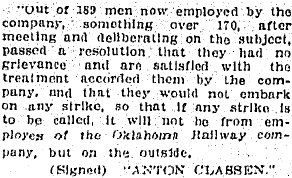 On March 5, shortly before the strike began, Anton Classen (according to this Oklahoman article) pronounced that a strike was “impossible” since an overwhelming number of ORC employees were satisfied with their handling by the company. A crop from that article is shown at the right.
On March 5, shortly before the strike began, Anton Classen (according to this Oklahoman article) pronounced that a strike was “impossible” since an overwhelming number of ORC employees were satisfied with their handling by the company. A crop from that article is shown at the right.
Anton Classen got it right — the strike did happen from the outside, and it happened in spades.
In his “Streetcar Strike” chapter, Terry Griffith says,
On March 5th, car number 60 left the streetcar barn with a non-union conductor and a motorman in charge, but very soon afterwards, the pro-union men advanced on the car and brought it to a standstill. The union then returned the car to the barn and their attempt to organize a union was made against the majority’s will. The strike began much like the one that blew up the Los Angeles Times Building. * * * Charles F. Colcord recalled the event in his autobiography. Everyone in the city was tired of walking and being controlled by imported thugs. Of the three hundred employees, only 12 or 13 of the workmen had joined the union. [After a meeting with various prominent citizens which was to no avail with the union supporters] They then called four hundred men from the rosters of the various city clubs to appear at the courthouse the next morning and bring their guns.
Actually, the number was 500 according to reports in the Daily Oklahoman. Initially, I said that the strike lasted until May 7, but that is not exactly correct. If “strike” means days that the street cars were not in operation, those days were March 5 – March 13; if “strike” means the date that union organizers agreed to submit the matter to arbitration, that day was May 7 — but whether ORC ever agreed to submit the matter to arbitration I’ve not been able to determine. It does appear that the last day involving conflict in the streets occurred on May 7.
Without detailing what I’ve located and overburdening this article, for those wanting more detail I’ve compiled several Daily Oklahoman articles which you can read to your heart’s content (all date references are to 1911):
- March 1: LE Patterson of Patterson Lines supports the strike
- March 5: Anton Classen speaks about how a strike is impossible since almost all employees oppose it
- March 6: Kerr Dry Goods offers free transportation to its store during strike
- March 7: Overholser Opera House does the same
- March 8: Strike continues and is described
- March 10: Governor’s order calling out troops rescinded; Kate Barnard (pro-union) and others are actively involved
- March 11: OCPD, whose members were apparently generally sympathetic to strike, were ordered to keep out — the Sheriff’s office takes over and deputizes 500 citizens armed with rifles to run trolleys and keep the peace; trolley service is resumed while parties negotiate
- March 13: The Daily Oklahoman’s editorial notes the possible positive national attention resulting from the strike
- March 13: Trolley operations resumed with aid of Sheriff’s office and his special deputies
- March 14: Trolley operations moving smoothly thanks to assistance of 500 crack-shot deputy sheriffs
- April 1: Another (actually a resumption of the existing) strike likely — ORC has not responded to union offer
- May 1: ORC hasn’t replied to union offer
- May 6: ORC fires 27 union employees, gives answer: Won’t recognize union
- May 7: Summary of the day; ORC offers $500 reward for info leading to conviction of lawbreakers
- May 8: Describes events occurring on May 7 — riots, injuries sustained by Police Chief and others, decision by union to submit matter to binding arbitration (which arbitration, if it occurred, I could not locate)
While I searched beyond May 7-8, I didn’t readily find anything — I may get back to tying the end of this matter down later, but probably not. The point should be made by now — Oklahoma City hadn’t seen a strike like this one when it happened, and it hasn’t seen one like it since.
Whenever it ended, the union activity, largely fueled by non-Oklahoman’s entering upon our turf, did not succeed in its goal of making ORC a union shop (i.e., mandatory union membership) and the city eventually returned to normal. Enjoy the historic nostalgia in looking back into a point of Oklahoma City history 99 years ago, as this article is written. For the most part, all those people in the street are ordinary citizens, mostly males in suits and hats, who are seriously outraged that their street car service has been disrupted. Click on any image for a larger view.
| Credit Griffith; on Grand looking east toward Herskowitz building in the distance | Credit: Griffith; Same perspective but taken from higher vantage point |
| Credit: Griffith; At Broadway & Main; meeting going on inside Lee-Huckins Hotel | Credit: Griffith; Street car workers parade on Broadway May 7 |
| Credit: Griffith; can’t identify location; grain elevator may be in upper right corner | Credit: VRP; I can’t identify location |
| Credit: VSP I; I can’t identify location | Credit: VSP I; Kate Barnard is speaking in favor of strike inside Lee-Huckins |
| Credit: Griffith; Okc Police Chief John Hubatka struck by trolley; others injured also
Note: Griffith says that the injured chief was Bill Tilghman, but he didn’t become chief until July 15. | |
THE GOLDEN STREETCAR ERA. The beginning of what I’ll call the “Golden Streetcar Era” began in 1902-1903 when John Shartel and Anton Classen merged forces and formed what came to be the Oklahoma Railway Company at a time that Oklahoma City encompassed not more than a handful of square miles in geographic size. In those beginning days, automobiles were still on most people’s wish list, if, in fact, that mode of transportation would prove to be superior to the horse and buggy method of getting around town, a fact yet undetermined. The northern boundary of Oklahoma City was then what we know as NW 13th Street today; Capitol Hill was not then part of the city; Western was the fringe border on the west and the eastern border was not that far east of the Santa Fe tracks. It was a time of competition between those vying to secure a grip on the development of public transportation in Oklahoma City, a competition which would ultimately be won by Classen & Shartels’ companies. This period is more particularly covered in Trolleys Part I.
As the period covered by this article, Trolleys Part II, begins, that motion is already well underway and is moving forward with a gusto.
The map below appeared in the March 20, 1910, Oklahoman and purports to show track in place and track proposed to be in place by the end of 1910. I haven’t checked for detail, but I doubt that all proposals got done. In that map, you will see that the interurbans have begun … at the south end, the note reads, “Interurban To Moore;” westbound the note reads, “El Reno Interurban” something (railroad, railway); at the north end, the interurban line which will later pass through Edmond and reach Guthrie ends at Britton. Notice, also, that two lines are shown in the map, the dominant Oklahoma Railway Company and, at the east side, the much smaller Citizens Traction Company. Click on either map for a much larger view.
| Original Map | Color Coded |
The second map was shown in Trolleys Part 1, from Allison Chandler and Stephen Maguire’s When Oklahoma Took the Trolley (Interurbans 1980). Recall that this map is a composite of the routes actually constructed, after the fact.
| Original Map | Color Coded |
Certainly, lots of similarities exist, but differences do, also. One obvious difference is that the 1910 map does not include the Belt Line track although it shows other railroad track. This is important since the ORC first leased, later purchased, and toward the streetcar system’s end sold, this route which was important in ORC’s freight business. Map aficionados may enjoy doing a closer comparison but I’ll resist the temptation here since that is beyond the scope of my purpose here.
Like Ron Popeil often says, you might say, “BUT WAIT” … where did all of that Oklahoma City turf which did not exist in 1903 come from by the end of 1910? In large part, that new city turf came from the efforts of Classen & Shartels’ Oklahoma Railway Company, who were Oklahoma City’s defacto unofficial city planners.
Even if they may have been and, I think, were operating under the capitalist model put forward by Alexis de Tocqueville, enlightened self-interest, capitalists they were and they doubtless knew that that there wasn’t a lot of money, if any, to be made by merely providing a system of public transportation — the initial perpetual franchise from Oklahoma City which covered a limited downtown area locked them in to sell fares at 5¢ a ticket. Given that hundreds of thousands if not millions of dollars would need to be spent to develop a streetcar system encompassing an enormous number of miles, even at that time’s relative value of the dollar, it doesn’t take an economic genius to count the nickles and conclude that, for a capitalist-oriented streetcar company to make money, particularly a lot of money, the money would have to come from sources other than the 5¢ ticket sales.
And, of course, it did. An enormous amount of ORC expansion occurred because the areas surrounding Oklahoma City were undeveloped and Anton Classen and John Shartel took advantage of the opportunity presented to expand the city’s footprint by their expanding streetcar routes through essentially uninhabited parts of the area surrounding Oklahoma City and by acquiring, developing, and selling, property along the expanding routes.
That process would quite likely have gone on for a longer period than it did but for the automobile which increasingly provided people the ability to go where they wanted and when, and then return home again when they wanted and when. But in the early 1900s – early-teens, when Oklahoma City remained a relatively compact even if expanding city, that’s the time that Anton Classen and John Shartel made their money — in real estate development.
In Oklahoma County – Heart of the Promised Land, Bob Blackburn notes that …
* * * With the opening of the interurban to Norman [in 1913], the company operated 103 miles of track, 95 passenger cars, 22 freight and dump cars, and serviced Oklahoma City, Putnam City, Britton, Edmond, Moore, Norman, Bethany, Yukon and El Reno — in short, all parts of Oklahoma County and beyond.
The transportation giant reached a peak of prosperity from 1913 to 1918. During that period the interurban was extended to Guthrie, the Briarwood, Fair Grounds, and Wheeler Park and were drawing good crowds, and the company was earning a substantial profit by selling excess electricity to utilities. * * *
The streetcar system expanded to accommodate a growing population. In 1900 the population of Oklahoma City was 10,000; by World War I it exceeded 60,000, a 600 percent increase.
Of course, Dr. Blackburn is speaking only to the profits of ORC itself, not to the profits obtained by ORC’s owners in acquiring, platting, and reselling lots to those along the expanded routes.
An aerial view of ORC’s car barn during this period of time gives a glimpse at the growth of the streetcar company in not more that 15 or so years since it began …
As late as February 2, 1918, Shartel, manager of ORC, was talking big plans after the Great War was over. Check it out …
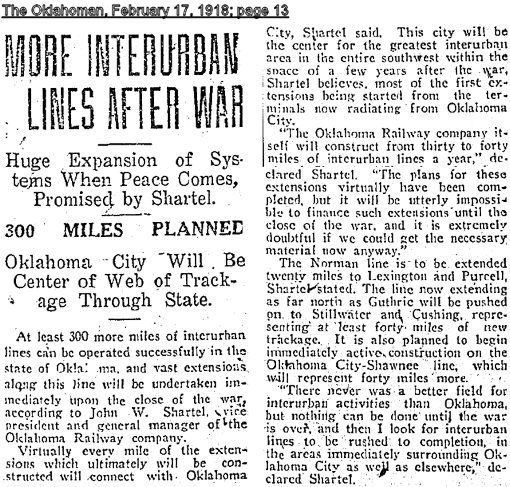
Whoa! That’s tall cotton … expanding the Guthrie Interurban to Stillwater and Cushing, extending the Norman line to Lexington and Purcell, and finally doing the long-promised Shawnee route.
END OF THE GOLDEN ERA. The problem was, Shartel had also begun voicing concerns about the profitability of ORC and the possible need to increase fares.
What had happened and/or caused this result? A lengthy and expository January 6, 1924, Oklahoman article nicely and thoroughly traces the advent of the automobile laced with the public’s affection for the goddess of convenience, and it’s a worthwhile read. Among other things, the article noted that records from the state highway department showed that, “the number of automobiles registered in Oklahoma City has increased since 1917, from 7,191 cars to 24,545 cars.” The article does not mention the impact of World War I (1914–18) which may well have been a factor, also … nor does the article mention that ORC may well have built more streetcar lines in the city than the city could realistically support.
In any event, in this June 19, 1918, article, Shartel is shown to have presented to ORC’s board the company’s financial difficulties and his proposal to increase various fees. It reached the point in December 13, 1919, article that Shartel, most likely facetiously, was reported as saying,
“If the citizens of Oklahoma City can run the street railway at a profit, I wish to haven they’d take them over and do it.” This is the answer of John W. Shartel, general manager of the Oklahoma Railway company, on his return yesterday from a conference with the owners of the system in St. Louis, to the threat of municipal ownership.
* * *
The railways are operating under a perpetual franchise so that unless the city could find a way to legally break its contract, the transfer of ownership would have to be at the company’s option. The franchise provides for a purchase by the city on a valuation basis only at certain fixed periods in the system’s existence. The next of these periods will not occur until 1928. ¶ The railway owners are confident though, that they have found a way out of their financial difficulties.
However, in 1920, the ORC engaged in a public campaign designed to persuade citizens to understand the need to increase increase single fares from 5¢ to 7¢. That proposal was approved by the city and the corporation commission. See this September 5, 1920, ad for more detail. Initially, at least, the fare increased resulted in a 10% ridership drop, according to this September 22 article.
Rate increase in hand and judging by the tone and content of a lengthy September 17, 1921, article which reads more like an infomercial, one wouldn’t know that things were not going well at ORC. The article boasted of ORC’s 66 miles of city tracks and its 85 miles of interurban connections, and added that, “It is understood that within a few months definite announcement will be made concerning construction of a line east to Shawnee.” More, terminals were to be enlarged and the article said, “Plans are also being pushed for a high speed entrance to the city by a combination of the Guthrie and El Reno lines which will eliminate all grade crossings and permit trains to enter the city at express train speed.”
However that may be, less than two years after getting its 1920 fare increase, ORC began to campaign for another, this time to raise the typical fare to 8¢. Despite the extensive campaign “to inform the people of Oklahoma City about the problems facing the Oklahoma Railway Company,” resistance from city leaders was stiff, and ORC’s ads which typically noted that the company had not paid dividends to its stockholders for more than ten years fell upon deaf and resistant ears. See this July 7, 1922, ad, for a typical example.
Where is Anton Classen in all of this processing? Even though he was president of ORC, he certainly was not the face of the franchise — that role belonged to ORC vice president and general manager John Shartel. Just the same, it is noteworthy to mention that the more gracious and less combative Anton Classen died on December 30, 1922.
Whether coincidental or not, events became fiery and frosty (yes, both) after Classen’s death, after which Shartel became president of the company. An October 14, 1923, article reported, under headlines reading, “Shartel Will Push Plea for Fare Increase – Head of Railway Line Avers No Compromise Will be Made With City – Says Firm Is Broke,” that the 8¢ fair increase and revision or removal of “certain non-sensical traffic ordinances” was “absolutely necessary and the plea is final and the company is in no position to back down.” “The company is broke,” Shartel, using a carrot/stick approach, was reported to say and that revision of the traffic laws and increased rates are the only things which will remedy present conditions and that “In case the rate is granted and new traffic laws made, electrification of the road to Shawnee and Atoka is promised.” But, the city commissioners (city council, today) decided to take no position but instead defer the matter to the corporation commission which would ultimately have to approve any rate increase. According to an October 25, 1923, article, that action was not enough to suit Shartel. The article begins by speaking the unspeakable, shutdown of the city’s streetcar system, it stating, “Operation of the Oklahoma City street cars will be stopped only as a last resort after all legal means of getting relief have been exhausted, John Shartel, president of the Oklahoma Railway company, announced Wednesday.” The article said that, absent the city’s endorsement, it would not proceed to complete negotiations for the Shawnee route, the article stating, “If the commission had taken a stand for the raise, negotiations would be opened immediately, he declared.” “The city commission’s refusal to recommend the fare has stopped any negotiations for the purchase of the Shawnee branch for the present, he said.”
Shartel’s heavy-handed carrot/stick approach was wearing thin and may have cost him needed local support in the business community as well as in the public at large. For example, the Daily Oklahoman entered the fray with its October 27, 1923, editorial, stating, among other things,
If the Oklahoma Railway company is shown by the evidence to be entitled to an eight-cent fare in the city, such a raise should be granted. But an increase in fare should not be given as a bribe or inducement for the company to take over and operate the outside [Shawnee] line. The proper way to handle the Atoka railway proposition would be for the chambers of commerce of Shawnee, and of other cities affected, to arrange for a joint meeting of their representatives to formulate some plan whereby the operation of that line could be financed.
What was Shartel’s response? “Let’s crank it up a notch.” The November 7, 1923, Oklahoman reported it this way:
Railway Chief Has Swan Song – Shartel Asserts He Will Ask Permission to Abandon Lines in City
Amid the solemn faces and hushed voices of the Lions Club, John Shartel, grizzled warrior of twenty years’ battles for the cause of the Oklahoma railways, gave what he declared to be the “swan song” of the corporation at the Skirvin, Tuesday noon.
“I expect to file and prosecute an application with the corporation commission immediately for permission to abandon the lines of the Oklahoma Railway company in Oklahoma City.” * * *
Following Shartel’s declaration that he was giving the swan song for the Oklahoma railways, George Lackey, program chairman, asked the members which they wanted – a benediction or just disband for the day. The speaker had held them tense during his vivid and somewhat pathetic account of the passing of a great company.
Lackey was then a director of the ORC board, as were R.J. Edwards, Mrs. Anton Classen, G.B. Treet, George H. Brauer, and Charles Hoopes. By the end of the month, ORC’s intention was fine tuned. A November 20 article states that:
Dismantling all city street car lines except approximately five miles, enough to retain the original franchise, will be sought in a petition to be filed with the corporation commission, it was announced Monday afternoon following a two-day meeting of the directors of the Oklahoma Railway company. * * * Interurban lines to the city are laid on private rights-of-way and the company will also seek to operate them, Shartel said.
* * *
[Mayor] Cargill declared, “He can’t run any bluff over me,” he added when declaring that he would issue a statement Tuesday as to what would be done by the city about the matter.
Are we having fun yet?
In a lengthy and perhaps the most comprehensive report that I located, a February 15, 1924, article reported on the findings and recommendations of an Oklahoma City Chamber of Commerce committee which had been set up to study and report upon the matter. I won’t detail its findings but the report presented a mixed bag of recommendations, ranging from favoring an increase to a 10¢ fare to opposing a general shut-down of the city’s streetcar lines — but this exceedingly brief summary is a vast oversimplification. Read the whole article for more.
I haven’t yet located what it filed exactly, but the ORC did file a petition with the corporation commission to dismantle a large part of the city’s streetcar routes, even though not perhaps as sweepingly as it had threatened to do. Whatever it did file, this May 1, 1924, article showed that when push came to shove, Shartel backed off and dismissed ORC’s petition before the corporation commission on the day it was scheduled for hearing. The article’s main headline is shown below:

Don’t look now, but John Shartel just blinked. The article continues …
Mayor Cargill drew first blood, Wednesday afternoon, when the Oklahoma Railway company withdrew its application before the state corporation commission asking the abandonment of one-third of the city’s street car lines.
* * *
Cargill has not ordered J. Frank Martin, city counselor to hold up on the petition asking for a receiver for the company in the district court but it is understood that the case will be held in “status quo” and not filed unless a fresh offensive is started by the railway company.
* * *
Early Wednesday morning, Shartel is said to have called Cargill on the phone and asked him what was his object in giving out an interview in Wednesday morning’s Daily Oklahoman to the effect that a receiver would be asked for the street car company.
The mayor, without “beating around the bush,” is said to have told Shartel that he meant, “fight” and “that they would either have to withdraw their application before the corporation commission, or the city would go to bat in the district court and ask for a receiver for the street car company.”
Shartel is said to have called his attorneys into consultation with the mayor. Cargill is said to have remained [illegible in the article], refusing to budge from his stand. “Withdraw the application and that will be all there is to it,” he is said to have told them.
In other words, Mayor Cargill told Shartel, “Pursue the application and the city will ask that a receiver be appointed; withdraw the application and we won’t.”
With the application before the corporation commission withdrawn, the rate still remained at 7¢, so ORC’s desire to increase the fare to 8¢ was not resolved. The R-word (receiver) had raised its head but just as quickly disappeared … for a time.
The Oklahoman’s archives (upon which I’m largely relying upon in putting this story together) aren’t particularly clear about what happened next. If the matter came before the city commission (council) again before September, I couldn’t find an account of that happening. Reports beginning in September 1924 seem to indicate that something remained pending before the corporation commission even though the petition to dissolve various routes had been withdrawn — perhaps it was the fare increase matter. But, a short recap appeared in the September 9 Oklahoman, seen below:
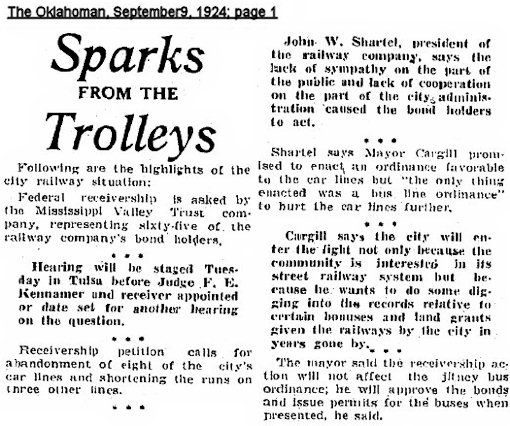
Receivorship! Spelling note: Standard dictionaries spell this word, “receivership” and use the form “receiver;” lawyer-speech typically uses “receivorship” and “receivor.” Mississippi Valley Trust Company, ORC’s largest creditor, filed a federal court receivorship proceeding in Tulsa against ORC, one of the elements of which was apparently an attempt to cause ORC to be more profitable and thus place it in a better position to pay on its bond indebtedness which was most probably in default (otherwise, Mississippi Valley would not probably have had status to initiate the proceeding). Note that the above summary sought to abandon 8 car lines and shorten 3 others. Note, too, that Shartel complained of recent Oklahoma City action which provided for the establishment of bus lines in the city. In the summer, Oklahoma City passed one or more ordinances authorizing the acquisition of “jitney buses” … “jitney” was apparently slang for 5¢ and “jitney buses” were small buses which transported passengers on a route for a small fare, a development which could further cut into ORC’s earnings.
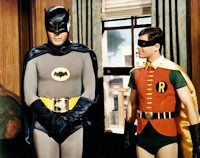 Holy Shenanigans Batman!!!!!! The next day’s Oklahoman contained an article evidencing the city’s willingness to get nasty and go to the mat. The September 10, 1924, article dropped some huge bombs the likes of which had not appeared in the press before … or if they did I was unable to locate statements like the following …
Holy Shenanigans Batman!!!!!! The next day’s Oklahoman contained an article evidencing the city’s willingness to get nasty and go to the mat. The September 10, 1924, article dropped some huge bombs the likes of which had not appeared in the press before … or if they did I was unable to locate statements like the following …
Intervention of the city in the receivership suit against the Oklahoma Railways company was heralded Tuesday afternoon with the filing of a petition in the federal district court charging “gross mismanagement.”
* * *
In applying as an intervener, the city asserts that regulatory ordinances operating under the street car company’s franchise have not been adhered to and that it is an interested body due to the 2 percent participation of the gross earnings of the company after the total maintenance of the company has been cared for.
* * *
Excerpts from the petition are as follow:
“Intervenor alleges that said street railway company has been operating in said city since 1902 and that during that period and at the present time has been grossly mismanaged both as to operation and finances; that every conceivable scheme in the past and is no resorted to for the purpose of defrauding the city of its 2 percent earnings.
* * * that said railway company’s lines have been extended to undeveloped parts of the city for real estate speculation and has not been extended to developed parts of the city where said operation could pay a large profit because of the fact that the element of real estate speculation was lacking.
That said railway company will not extend its lines to any portion of developed or undeveloped part of the city unless said railway company or its subsidiary corporations own large tracts of land near or adjacent to said extension or that large bonus either in cash or property is paid to it or its subsidiary corporations. * * * That said railway company has in fact been used as a promotion company for certain subsidiary companies from which said subsidiary companies have derived large amounts of profit.”
 But, not to be outdone, a few days later, per this September 24 article, ORC made a move of its own and filed a request with the corporation commission for an immediately effective emergency order granting a temporary 10¢ fare while the rate matter was pending, in addition to other requests. This September 25 article indicates that the the city was uncertain of what its response to that request would be and, significantly, that Mississippi Valley might dismiss its receivership proceeding were that request to be granted. A September 27 follow-up article reported that:
But, not to be outdone, a few days later, per this September 24 article, ORC made a move of its own and filed a request with the corporation commission for an immediately effective emergency order granting a temporary 10¢ fare while the rate matter was pending, in addition to other requests. This September 25 article indicates that the the city was uncertain of what its response to that request would be and, significantly, that Mississippi Valley might dismiss its receivership proceeding were that request to be granted. A September 27 follow-up article reported that:
Oklahoma Cityans probably will pay ten cents car fare in October, it was indicated Friday when a series of plays across the checkerboard of the street railway situation ended with the Oklahoma Railway company dominating king-row and with the board cleared of opposition. ¶ An agreement between the traction company and the commission was virtually sealed when the city solons passed a twenty degree parking ordinance on downtown streets and barred the operation of jitney buses on streets with street car lines. ¶ In return for the favor granted by the city commission the railway company assured the commissioners that the suit for a receivership filed by the Mississippi Valley Trust company as bondholders of the company in the federal court would be dismissed Monday when it came to a hearing.
The “20 degree parking ordinance” referred to above was a sore point with ORC — at greater parking angles, when automobiles backed out from their angled parking spaces cars would pass directly over streetcar lines thus impeding streetcar flow as well as increasing collision opportunities. Ordinances adopted much later would change on-street parking to parallel, but that was not then the case.
On the emergency rate increase request, the corporation commission granted an 8¢ raise and some additional relief and the also pending receivership hearing was continued until January 1925. At the time, Shartel indicated that, all things considered, the temporary raise might be enough. See this September 30, 1924, article where he was reported to say,
In a later statement Shartel said the company is satisfied with the 8-cent fare. “We estimate a gain of 1¼ cent a person over the old rate,”he said, “which will give us approximately $150,000 more a year. If this rate doesn’t work out, we are through. I will not ask for a higher rate as the public traffic could not stand it.”
But, was it enough for Shartel? Apparently not, since he indicated shortly thereafter that he intended to pursue the 10¢ permanent request before the corporation commission. That position drew the ire of Mayor O.A. Cargill and others, per this November 19 article. Shartel explained his position in a December 2 article. With the outcome of permanent request before the corporation commission looming, a hearing on the federal court receivership proceeding, initially scheduled for January 15, 1925, would instead occur before the end of December before Federal Judge F.E. Kennamer.
As to ORC’s pending hearing before the corporation commission, it was scheduled for December 5, 1924. Scour the Oklahoman’s archives as well as I could — and I looked closely at every page beginning December 6 and the 7 days following, and rather closely through June 1925 — I was not able to locate another mention of it one way or another. Whether the hearing was abandoned, held, or continued, I am unable to say. As you will shortly see, a receivership was established at the end of December and as an indirect check I attempted to determine fares charged by ORC for more than a year beyond that time, but, unfortunately, no fare information could be found.
As to the receivership, it was scheduled for hearing on Saturday, December 27. Before then, Mayor Cargill and others made a pitch to Mississippi Valley drubbing the competency of John Shartel, as reported in this December 18 article, apparently in an attempt that Shartel not be appointed a receiver in the matter. A morning-of-hearing December 27 article queried whether the respective players still had unplayed remaining “trump cards” and anticipated a multi-day hard fought trial, but that apparently proved not to be the case. The next day, Sunday, December 28, contained the Oklahoman’s report. The less-than-a-day trial produced few surprises (the trustee objected to Oklahoma City’s intervention but that was apparently allowed) and resulted in the appointment of George Henshaw, former corporation commissioner commissioner, and John Shartel, co-trustees, per this December 28, 1924, Oklahoman article. But, Shartel, apparently appointed at the behest of the bondholders, was not the main man, Henshaw was. According to the same article, Shartel termed himself as “merely the hired hand.” In an un-classy and pointless move on December 31, an angry Mayor Cargill caused a motion to be filed which requested that Shartel be removed as co-trustee, for the reasons stated in this January 1, 1925, article. In the article, Shartel is quoted as not caring about the motion’s outcome one way or another.
And, why would he be that much concerned? The days of the original regime were done — the days of capitalist risk-taking by investment in what might, or might not, pay off by taking an almost treeless and barren area surrounding downtown’s small core and betting on the come that the areas might, could, and would become something much more than that, something better than what he and Classen had in their beginning days with Oklahoma City streetcars. Was he the nicest guy you would ever want to meet? Probably not. Was he as concerned about aesthetics (i.e., landscaping and the planting of trees) as Classen was? Probably not. Did he help form the city’s neighborhoods spoking out from downtown’s core that you and I now take for granted and are glad to have? Absolutely.
Anton Classen died on December 30, 1922. Two years later the receivership was established over the ORC, on December 27, 1924. Personally, I see that date as the effective death of John Shartel as a mover and shaker of the once powerful Oklahoma Railway Company. The receivership lasted for several years (I’ll pin the end date down later) and Shartel continued as co-trustee during the remainder of his life, until his physical death on April 13, 1926, at the age of 63. Read the full article for much more information, but a couple of snippets are set out below.
As the funeral cortege takes up its line of march, street cars and busses will become motionless for two minutes, to honor the passing of the second of the organizing officials of the Oklahoma Railway company.
Did the events leading to ORC’s receivership contribute to his death? The article notes that,
His closest friends and members of his family believe that the receivership of the railway company was the thing that started Shartel on the downward trend, climaxing with his death.
Although the Oklahoma Railway Company would survive the receivership as a legal entity and streetcars would last until 1946 (streetcars and all but the Norman Interurban) – 1947 (Norman Interurban), no one with one eye open to the span of history would say that ORC was ever the same. The golden era was done. The remainder of the streetcar story is told in the Last Years section of this article, below.
THE MIDDLE YEARS. The 1920s’ receivorship proceedings which ended the story of Anton Classen and John Shartel’s creation and establishment of the Oklahoma Railway Company lines wasn’t the end of the story for streetcars in Oklahoma City, even if that receivorship did mark what I’ve called the end of the “Golden Era.” I don’t mean to imply that ORC didn’t have successes after that time, but they were different than those during the grandiose period of capitalist expansion and development of the geography of the city during the time. The earlier city allegation, “that said railway company’s lines have been extended to undeveloped parts of the city for real estate speculation and has not been extended to developed parts of the city where said operation could pay a large profit because of the fact that the element of real estate speculation was lacking,” was almost certainly true. But, the reverse side of that coin is that, otherwise, places like University Addition, Putnam Heights, Military Addition, and many others in the city came to exist for the exact reasons that ORC was being faulted for.
That element, city expansion, was not a part of the new regime’s focus which, in a nutshell, was much more concerned about making the streetcar system more economically viable. This is not to say that expansions did not occur after the earlier receivorship came to an end but, for the most part if not altogether, those expansions were not based on increasing the footprint of the city.
… MORE TO COME …
THE LAST YEARS.
… more to come and skipping forward considerably …
Even with the hastening demise, as late as 1945, ORC was still looking for new ideas, and possible new routes. Even though neither the proposed routes nor the proposed vehicle ever materialized, the item below was on the drawing boards. When Oklahoma Took The Trolleys includes the following image and description of a hybrid electric street car and rubber tire vehicle:
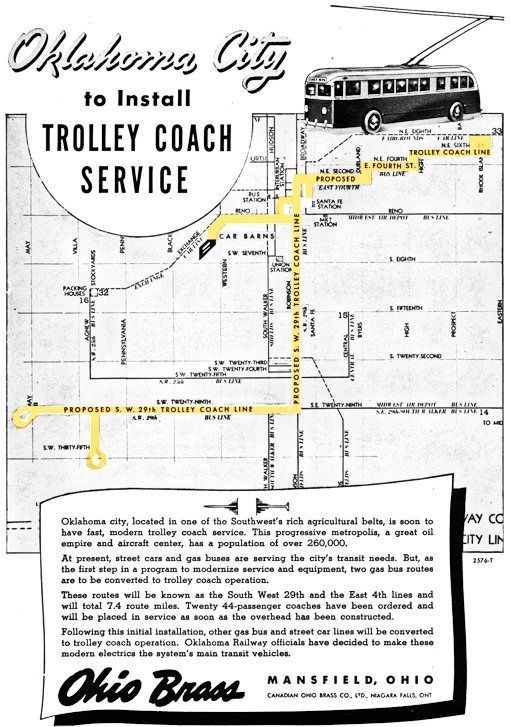
Ed. note: The description of the above in When Oklahoma Took The Trolley contains incomplete sentences. I’ve modified the original text to be what I think the authors intended. What might have been: Management of Oklahoma Railway Co. briefly considered substitution of trolley coaches for streetcars. Ohio Brass 1945 advertisement is industry bible. Mass Transportation detailed a proposal for linking East Fourth streetcar and S.W. 29th bus line into a new TC route. But electric buses never got beyond the talking stage, and no city in Oklahoma ever had them.
As stated above, the new ideas were not to materialize. Oklahoma City’s intra-city routes which had not already been shut down by then were closed in 1946. The Interurban to Norman hung on until its last run in 1947.
I cannot possibly begin to tell the story of the very last days better than Allison Chandler and Stephen D. Maguire did in When Oklahoma Took the Trolleys at pages 19-20 of their excellent book. Consequently, I’ll quote from those pages, verbatim:
| The beginning of the end for ORC’s rail operations occurred in the fall of 1945 when the operators of the Oklahoma Transportation Co., a major Oklahoma intercity bus line, bought the assets of the Oklahoma Railway Co. and reorganized the company. Principals of the new management were Eugene Jordan and Robert S. Bowers. Proceeds from the sale of the freight operations, later disposal of the downtown terminal, and other real estate, put the firm back into solvency and enabled the new owners to proceed with a near debt-free company.
Jordan and Bowers promptly petitioned the corporation commission for permission to abandon the three interurban lines and all remaining city streetcars. There was little opposition to all of this—save the proposal to close the Norman division. Nearly everybody in Norman, it seemed, from the president of the university on down, demanded retention of the interurban. Much to Jordan and Bowers’ chagrin, there were even proposals to upgrade the line into a true rail rapid transit line. Forrest D. Monahan, Jr., in his article on the Norman interurban in the book, Railroads in Oklahoma, Oklahoma Historical Society, 1977, described the alarmed reaction from Norman division boosters:
Meantime, an anxious ORC lost little time in closing down the other two interurban divisions. With OCC blessing, on Saturday, November 9, 1946, both the Guthrie and El Reno lines were abandoned, the last cars leaving the downtown Oklahoma City terminal in the wee hours of the morning. The ORC did not offer replacement bus service, although intercity bus lines served both cities from the capital. Due to an inability to get delivery of replacement buses fast enough, scheduled curtailment of the five remaining city streetcar lines had to be postponed from 1946 to 1947. The fate of the Norman line remained up in the air. Its patronage, while certainly not up to wartime levels, remained much higher than the Depression; in May 1946, passenger revenue of $20,000 was four times the level of 1940; car mileage was twice the 1940 figure. As the fall season arrived, ORC found, true to University President Cross’ predictions, that it had to schedule two- and three-section trains to handle the crowds of commuting students. The Oklahoma Railway also stubbed its toe in its choice for lobbyist and spokesman in the changeover from rails to buses. The company hired New York transit consultant Col. Marmion D. Mills, an outspoken proponent of rubber-tired transport, to supervise the battle. Mills quickly became a controversial figure, and became embroiled with angry commuters, politicians and the newspapers as almost daily headlines kept the fight raging. Suddenly, the company withdrew the abandonment petition. Mills stopped making statements (he was soon off to San Francisco to begin a partially successful campaign to rid the City by the Golden Gate of its streetcars) and quiet prevailed. By April 1947, the last of the city streetcar lines had been converted to buses. But the Norman interurban cars were still rolling. In September of 1947 the company made its move. The Oklahoma Transportation Co. (also owned by Jordan and Bowers) put on a new schedule of 39 round-trip bus runs to Norman, nearly duplicating the rail service. Inevitably, interurban riding fell off. Meanwhile an elaborate new plan for a highway system in and near Norman took attention away from the interurban and its tracks. Suddenly, visions of new freeways altered the picture. In early September 1947, the Norman city government changed its tune completely and decided it wanted to put a street on the interurban right-of-way within the city limits. The Norman Transcript advocated that the entire rail line be converted into a four-lane highway. Thus, in a much stronger position, the company again petitioned for abandonment. When organized opposition failed to appear at the OCC hearing of September 18, 1947, the Norman interurban’s fate was sealed. Approval was quickly granted, and, on the night of September 27, 1947, car 227 (one of the ex-Rockford interurbans) made the last northbound trip from Norman to the Oklahoma City terminal. |
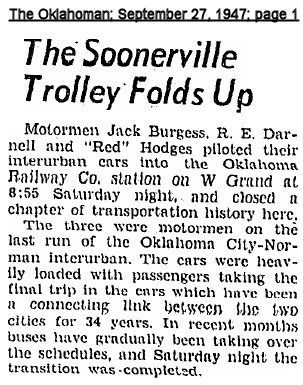 A very small article in the September 27, 1947, Oklahoman gave passing but not particularly noteworthy respect to a hugely important era of Oklahoma City’s history which had finally come to its end. Even though a page 1 article, in effect, it’s barely more than a footnote and, at the time, maybe the city didn’t really care that the city’s 1902-1947 (45 year) streetcar history had come to an end.
A very small article in the September 27, 1947, Oklahoman gave passing but not particularly noteworthy respect to a hugely important era of Oklahoma City’s history which had finally come to its end. Even though a page 1 article, in effect, it’s barely more than a footnote and, at the time, maybe the city didn’t really care that the city’s 1902-1947 (45 year) streetcar history had come to an end.
As the end drew near, more and more streetcars became sidelined into the pastures around the Car Barns where they deteriorated by reason of age, weather, and neglect. Many were eventually sold to interests in Mexico to replace streetcars there which were even older, but others suffered a more ignoble fate, like the car below which was sold locally and became a barber shop somewhere in the bowels of the city … credit for both photos: Vintage Rail Photos.
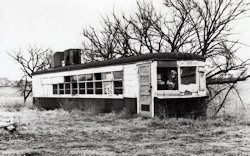 |
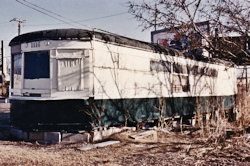 |
Since the photo below is not dated, I cannot say which of the two closures … 1946 or 1947 … the ORC employees below are relating to, but it was certainly one or the other.
Whether the event was the 1946 or 1947 end-of-line, the message is the same.
THE INTERURBAN LINES. Multiple early-day streetcar companies promised 4 (if not more more) interurban routes, to Guthrie, El Reno, Norman (actually further south as far as Purcell), and Shawnee. Only the Shawnee line never materialized. Taken together, the completed interurban routes totaled 138.2 miles and represented ORC’s greatest construction expansion. When Oklahoma Took The Trolley says that between 1913 and 1918, more than 50 new cars were purchased. The following photos show ORC interurban streetcars to or from those respective locations. As always, click on a small picture for a much larger view.
Guthrie. Like everything else in the ORC inventory, this project was built in stages, steps. The 1st step was to Belle Isle, the northern part of the ORC streetcar system in Oklahoma City. The route expanded to Britton by 1909, then to Edmond in 1912, and in 1916 to Guthrie which originally had its own streetcar system before the ORC interurban expansion occurred. It was ORC’s longest interurban at 31 miles. This route’s last run was November 9, 1946.
| Credit: VRP; Crossing Wilshire toward Britton | Credit: Blackburn; Edmond in 1889 showing Santa Fe tracks |
| Credit: VRP; Guthrie’s own streetcar | Credit: VRP; Interurban In Guthrie |
El Reno. El Reno also had a streetcar line, the El Reno Interurban Railway Co., organized in 1909. Operating a small route in El Reno, it had also started building west from Classen along NW 39th to Yukon. The ERIR was acquired by ORC in 1911 and the line was completed to El Reno in December 1911, with stations in Bethany, Yukon and, of course, El Reno. This interurban was 29 miles in length. The last run to El Reno was on November 9, 1946.
| Credit: VRP; building line to El Reno | Credit: WOTT; Near Highland Beach 1940
Grand Blvd. is probably under the trestle |
| 1940s Map Showing Highland Beach Crossing | Credit: WOTT; Bethany Station 1940 |
| Credit VRP: Yukon Station 1940s | Credit: VRP; in El Reno 1940s |
Norman. This 18-mile interurban was ORC’s shortest but most profitable operation as well as the most enduring. The line was completed from Capitol Hill to Moore in 1910 and, in 1913, to Norman. During World War II, with Norman being the home of two naval bases, use of this interurban line skyrocketed. But, those bases abruptly closed in 1945 following the war’s end, and the line, although still profitable, was not desired by the interurban’s then owners to remain alive. After strong protest, the last ride occurred on September 27, 1947.
On June 17, 1944, the line also produced the most serious accident in the city’s streetcar history.
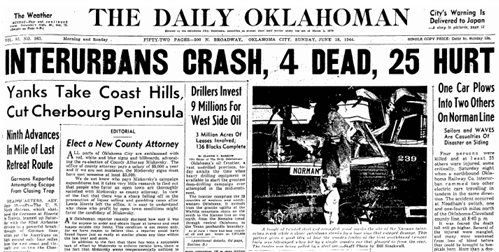
The next day’s Oklahoman carried the story, as seen in the headline and photo above. The full story reported that, at 1 ¼ miles north of the Cleveland County line at 8:40 p.m., a northbound interurban traveling at about 30 m.p.h. rammed into two stationary interurban cars which were sitting motionless on a siding waiting for a southbound interurban to pass. The crash caused the pair of interurbans to “telescope” and resulted in the death of 3 passengers and 1 employee and injuries to 35 others according to reports later than the June 18 Oklahoman article. Excerpts from the June 18 article appear below.
The force of the crash forced the third interurban 15 feet into the rear of the second, and the front end of the second about 10 feet into the rear end of the first. ¶ The first interurban was the only steel car of the three. The other two were of wooden construction. ¶ The three interurbans were bringing approximately 150 passengers, mostly sailors and WAVES from the Norman bases to Oklahoma City for their usual Saturday night outing.
While official responsibility for the tragedy was still to be fixed, all observers agreed unofficially that the third car involved ran through an open switch and into the rear of the first car and its trailer, which were motionless on the siding while waiting for a southbound car to pass.
The Oklahoman’s account of injuries was pretty grizzly, so skip the next quotes if you want to avoid the graphic description of what occurred when the southernmost trolley collided with the motionless pair of cars on the siding:
“I looked back when he was about a block away, and the next thing I knew he was right on us, [J.H.] Eskridge said. * * * [Andrew D.] Hopper [employee operating the southernmost interurban] was killed outright as was an unidentified WAVE, the top of whose head was shorn off by flying debris. The third and fourth deaths were women civilians. Bodies of several of the injured were pinned under the wreckage. Most of the casualties were in the third car which was under Hopper’s control.
Sailors riding in the rear of the second car saved themselves at the last minute by running to the middle of their car. As the inured screamed, stunned navy boys jumped from windows and out of the back door, but quickly returned to help in the rescue work. ¶ Both of the interurbans, traveling in tandem, had all seats filled and many were standing when the crash came. The two old wooden interurban cars splintered badly and debris littered the track for 100 yards.
Generally, although accidents, sometimes resulting in fatalities, did occur in the city’s streetcar history, the overall record of safety had been a good one. But, unfortunately, that was not the case on June 17, 1944.
For more about the last year of the Norman Interurban, see The Last Years, below.
Here are a few photos of interurban traffic to and in Norman. Click on any image for a much larger view.
| Credit: VRP; on way to Norman | Credit: VRP; on way to Norman
Credit: WOTT: 1945 North Canadian crossing |
| Credit: WOTT; 1946 North Canadian crossing | Credit: VRP; Norman Station @ 1913-15 |
| Credit: VRP; in Norman @ 1920s | Credit: VRP; in Norman @ 1940s |
| Credit: VRP; in Norman @ 1940s | Credit: WOTT; in Norman, 1946 |
FREIGHT & UTILITY ELEMENTS , BELT LINE, & THE STOCKYARDS. Strange as it may seem, a good bit of the information I have to present on this subtopic comes from a guy I’ve not met other than by e-mail exchanges which have been off and on since October 2007. He and his brother have a thing about researching old train routes and Oklahoma City got picked for part of their study. He’s the guy that provided the spark that led to the article on the Wichita Truck Company operations in the Packingtown vicinity. For the images supplied by him, I’ll use this credit: Credit: SHED.
This section will be developed more fully shortly. But here are the images … as usual, click on a pic for a larger view.
Freight Routes in August 1928; credit SHED
Click the map for larger view; Click here for unmarked map
ORC Freight Ad Circa 1930s; Credit SHED
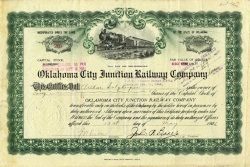 The Oklahoma City Junction Railway. Unless citizens live in or near the Capitol Hill area, they might not be aware that a very old railroad line, The Oklahoma City Junction, runs from the Santa Fe tracks westward and into Packingtown, and that it had an extension (which may not have been part the line, I’m uncertain) paralleling the Santa Fe tracks into the warehouse district where it connected with various larger railroad lines. The doctored-up 1922 Sanborn Map below shows its route – of course, the course of the North Canadian was different then and Wiley Post Park didn’t exist when the map was drawn, but everything else shown below did. The east/west track still exists, today being part of the Stillwater Central Railroad. For the stock certificate image, above right, credit SHED.
The Oklahoma City Junction Railway. Unless citizens live in or near the Capitol Hill area, they might not be aware that a very old railroad line, The Oklahoma City Junction, runs from the Santa Fe tracks westward and into Packingtown, and that it had an extension (which may not have been part the line, I’m uncertain) paralleling the Santa Fe tracks into the warehouse district where it connected with various larger railroad lines. The doctored-up 1922 Sanborn Map below shows its route – of course, the course of the North Canadian was different then and Wiley Post Park didn’t exist when the map was drawn, but everything else shown below did. The east/west track still exists, today being part of the Stillwater Central Railroad. For the stock certificate image, above right, credit SHED.

The 1930s map below shows how the Okc Junction (sometimes called “Belt Line”) fed into the Packingtown area.
… more text to follow …
| Credit: VRP; On The Beltline | Credit: VRP; On The Beltline |
The Stockyards.
| Credit: VRP; Wilson & Co @ 1940s | Credit: VRP; Morris & Company |
| Credit: VRP; Stockyards Track | Credit: VRP; Stockyards Office @ 1940s |
| Credit: COC; Packingtown | |
Utility & Freight Cars
| Credit: VRP; The President | Credit: VRP; The President |
| Credit: VRP; No. 601 | Credit: VRP; No. 601 |
| Credit: VRP; Freight Motor Car | Credit: VRP; Crane Car |
| Credit: VRP: Ballast Cars | Credit: VRP; Freight Motor With Coal |
… more to come …
THE NORTH CANADIAN RIVER FLOODS. Some preliminary photos showing a pair of devastating 1923 floods appear below. More descriptive text will shortly appear. Click on any image for a larger view.
| Credit: VSP II | |
| Credit: Griffith | Credit: Griffith |
| Credit: Griffith | Credit: VRP |
| Credit: VRP | Credit: VRP |
| Credit: VRP | Credit: VRP |
| Credit: VRP | Credit: VRP |
| Credit: VRP | Credit: VRP |
| Credit: VRP | Credit: VRP |
| Credit: VRP | Credit: VRP |
| Credit: VRP | Credit: VRP |
| Credit: VRP | |
EMPLOYEES OF THE ORC. Text for this section will be added shortly.
| Credit: VRP; Stockyards Crew | Credit: VRP; Working Shops |
| Credit: VRP; Freighthouse Crew | Credit: VRP; Motorcar Men |
| Credit: VRP; Motorcar Men | Credit: VRP; Employee Picnic |
PHOTOS AROUND THE TOWN. Here, I’ll just show some eye-candy of streetcar scenes around town during 1915-ish-years into the 1940s. Click on any image for a larger view.
The scene above, reminiscent of 1911 when hundreds of people poured into downtown city streets to protest the 1911 railroad strike, was perhaps the last “glory” photograph of Oklahoma City streetcars. The cars shown above would no longer be running a year later, and the last streetcar vestige, the Norman Interurban, would make its last run a year after that.
REMNANT TROLLEY TRACK AROUND TOWN. When all of the above is substantially done, I’ll take a drive around town to identify remaining streetcar track remnants. If you know of some, please add a comment so that I’ll go there to get a photo.

